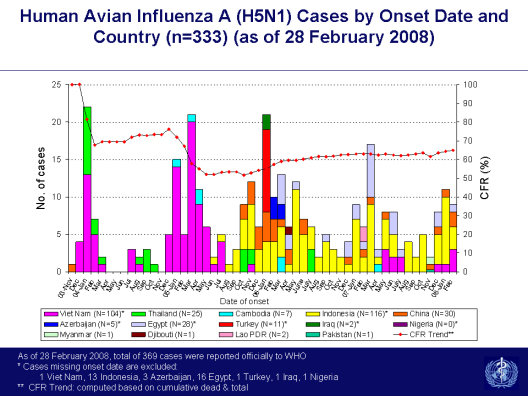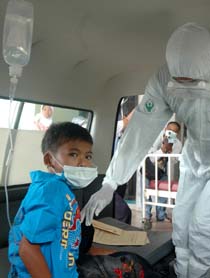Entries by Scott McPherson (423)
When Zhong speaks, we'd better listen
 Zhong Nanshan is on his soapbox again. And the world would do well to listen to him.
Zhong Nanshan is on his soapbox again. And the world would do well to listen to him.
For the uninitiated: Zhong Nanshan is Director of the Guangzhou Institute of Respiratory Diseases. Guangzhou is located in the Cradle of Global Infectious Respiratory Disease, Guangdong province, China. Guangdong is just north of Hong Kong. Guangzhou is a dynamic city to work in if you are a public health professional. That is because they pretty much see everything there is to see in Guangdong. Bird flu. SARS. TB. You name it, it either starts there or winds up there.
Zhong is at the center of the storm, and that is metaphorical. Not only is he at the center of the disease storm, but his outspoken nature also creates a bit of a storm when he gets his dander up. I point to Karl Taro Greenfield's seminal work on the history of SARS, the book China Syndrome. If you have never read that book, hit Amazon now and pick one up. His work in the early stages of the disease, as well as his antagonizing of the old-guard ChiCom political leadership put him doubly in harm's way. His ability to end (at least temporarily) the truth embargo may have helped facilitate the demise of that old guard. For a brief history of Zhong Nanshan, you can read this article: Uncompromising doctor - Zhong Nanshan.
Now for today's news: The same flu epidemic that is strangling American emergency rooms is apparently also choking its Chinese counterpart facilities. This H3N2 derivative, which we suspect is Brisbane, has caused several deaths among Chinese children and led to the closure and decontamination of at least one Hong Kong school.
Zhong has issued a stern warning to the Chinese people in particular (and to the world in general) that H5N1 is mutating (again) at a time when traditional, seasonal influenza is about to reach a peak this month in China. His concern is straightforward: These may be the most favorable pandemic conditions in southern China since the original Hong Kong outbreak of human H5N1 in 1997.
Here is the Reuters story:
Bird flu shows signs of mutation - China expert
(Adds closure of Hong Kong school)
HONG KONG, March 11 (Reuters) - A Chinese expert on respiratory diseases says the H5N1 bird flu virus has shown signs of mutation and urged vigilance at a time when seasonal human influenza is at a peak, newspapers reported on Tuesday.
"When avian flu is around and human flu appears, this will raise the chances of avian flu turning into a human flu. We have to be very alert and careful in March," Zhong Nanshan was quoted by the Ming Pao newspaper as saying.
"People who were killed by bird flu last year and this year were too poor to seek treatment. If you happen to have high fever and pneumonia, you must seek treatment fast," said Zhong, director of the Guangzhou Institute of Respiratory Diseases in China's southern Guangdong province.
Experts are worried about seasonal flu, because it could get mixed up with a deadly novel strain, such as the H5N1 bird flu virus. Such a hybrid would not only become easily transmissible between people, but packed with great killing power.
"The bird flu virus has shown signs of mutation. If infected people don't get treatment in a timely manner, they can die easily," Zhong was quoted as telling reporters on the sidelines of the Chinese parliament's annual meeting.
Three Chinese have died this year of H5N1 bird flu and they were infected probably through contact with sick poultry. The World Health Organisation said there was no evidence of transmission between humans in all three cases.
In Hong Kong, the government shut a primary school early ahead of the Easter holidays after one of its students, a 7-year-old boy, died at noon on Tuesday. The boy was admitted to hospital last week with flu-like symptoms and authorities are still trying to determine the cause of his illness.
Thomas Tsang, controller of the Centre for Health Protection, said five other pupils at the school have been admitted to hospital for respiratory infection and their conditions were stable. Three samples have tested positive for influenza A, Tsang said, without specifying the strain.
"The school will close early for Easter from tomorrow ... to facilitate disinfection," Tsang told a news conference. But he said there was no reason to close all schools in Hong Kong, although they would monitor the situation closely.
Hong Kong, which lies at the south of China, is in the grip of a seasonal flu peak, with outbreaks reported in a growing number of schools.
A 3-year-old girl died last week of human H3N2 flu and authorities have ordered schools to conduct fever checks and advise those who are unwell to stay home.
Although the H5N1 virus has infected only 368 people around the world since 2003, its mortality rate has been high, killing 234 of them. (Reporting by Tan Ee Lyn and Donny Kwok; Editing by Jeremy Laurence)
Superbug blogsite dedicated to tracking MRSA
 I was over at Mike Coston's blogsite, Avian Flu Diary, looking for ideas to poach. JUST KIDDING, MIKE! Anyway, I saw his reference to a new blogsite named "Superbug."
I was over at Mike Coston's blogsite, Avian Flu Diary, looking for ideas to poach. JUST KIDDING, MIKE! Anyway, I saw his reference to a new blogsite named "Superbug."
The architect and blogger at Superbug is a woman named Maryn McKenna, who is an author of note. Her book Beating Back the Devil: On the Front Lines with the Disease Detectives of the Epidemic Intelligence Service is in my personal library in my Man Room at home, and she has written for many publications, most notably CIDRAP. By the way, you can order her book at Amazon using this link: http://www.amazon.com/Beating-Back-Devil-Detectives-Intelligence/dp/0743251326/ref=pd_bbs_1?ie=UTF8&s=books&qid=1204837853&sr=8-1 .
Mike reminds his readers that Maryn wrote an excellent series on the vaccine situation, and links to that series can be found on Mike's site at: http://afludiary.blogspot.com/2008/03/welcoming-new-blogger.html
Anyway, now that you are back from ordering her book: She is researching a book on MRSA,. As you know, I have written several blog entries on MRSA, so it is most welcome that someone is picking up the gauntlet full-time and dedicating a sizeable portion of her time and intellect toward monitoring and documenting this topic. I have created a link to Superbug on this Blogsite, and you can also find her at: http://drugresistantstaph.blogspot.com/ .
Welcome, Maryn!
Reveres publicize excellent WHO "yardstick"
 Yesterday, I delivered a blog on the State of Bird Flu 2008. In that blog, I mentioned:
Yesterday, I delivered a blog on the State of Bird Flu 2008. In that blog, I mentioned:
"Look at the latest WHO stats and extrapolate them over a year. By any yardstick, 2008 could shape up to be like 2005 or even exceed 2006."
Thankfully, the Reveres of Effect Measure published the latest WHO chart, which allows us to look at the onset of human H5N1 cases by year and by nation. I am grateful they chose this time to help reveal this chart, which they interpret as showing 2008 as trending more toward last year than previous years. I am deferring to the Reveres' interpretation, since they are much better trained than this blogger at statistics. Obviously, I hope they are eventually proven right and I am wrong!
What is also interesting about this WHO chart is the shifting distribution of human bird flu cases over the years. This also, in my opinion, graphically shows us the dramatic effects of government intervention, culling, and awareness efforts when done properly. It also shows us what we cannot know, sitting in our offices and living rooms around the Core, as Tom Barnett would say: And that is how honest certain nations are when it comes to the reporting of cases.
Here's what I mean about cause and effect:
As you can see, from 2003 to 2005, Vietnam was Ground Zero when it came to human H5N1 cases. This prompted an unprecedented and extraordinary commitment of resources by the Vietnamese government to the containment and eradication of bird flu within the borders of that nation.
In response, by early 2006, Vietnamese human bird flu cases almost vanished. However, in that same time frame, Indonesia began its run as the new dominant nation for the detection of human bird flu cases. This dubious distinction has continued unabated ever since.
As Vietnam receded, Egypt joined Indonesia as the most prominent national hosts of human H5N1 cases. And then, as if calling out not to be forgotten as the veritable Cradle of Human H5N1, Chinese cases began to reappear. From late 2005 to mid-2007, these three nations comprised almost all human bird flu cases.
And then, despite all the work, education, planning and probable affront to human rights the Vietnamese government threw at the bird flu problem, human cases began reappearing there -- and have continued ever since. So their countermeasures may have been effective, but sadly, only temporarily so.
Staring out at you from the exact center of the graph is the Turkish outbreak of late 2005/early 2006. This fire engine red color serves as a warning to all that H5N1 can appear without notice and without warning and, therefore, vigilance is absolutely required -- everywhere.
The Reveres of Effect Measure remind us in their blog that...
Their blog can be found at http://www.scienceblogs.com/effectmeasure/ and the WHO chart can be (thankfully) seen full-size at http://www.wpro.who.int/NR/rdonlyres/7165D4BF-D820-4CB5-A1FD-267F905639D8/0/s2.jpg .If you look at the bar chart below you will see that this year's bird flu season is shaping up to look pretty much like last year. In the first two months of the year there are a few more cases but essentially the picture looks much the same. If that is indeed true, then also expect a spike of cases this month (March) since you can also see that is the past pattern. Already cases are being reported in Egypt, and of course, Indonesia. The countries involved this season have been Vietnam, China, Egypt and Indonesia, just like last year. Whether you consider that reassuring or worrying probably depends on whether you are an optimist or a pessimist. We tend to be cautious pessimists. Your mileage might vary.
Pandemic fatigue gives way to the "H5N1 New Normal"
 You know, the news on the bird flu front is kinda quiet right now. Aside from Egypt, which has had a few cases and accompanying deaths over the past two weeks, and the expected weekly cases from Indonesia, things are relatively calm.
You know, the news on the bird flu front is kinda quiet right now. Aside from Egypt, which has had a few cases and accompanying deaths over the past two weeks, and the expected weekly cases from Indonesia, things are relatively calm.
We have come to expect daily stories of poultry culls in the third world, in this nation and that nation, and we are not surprised at all when a human case pops up, usually in Tangerang or West Jakarta or Vietnam or even China. Just as H5N1 has become endemic in poultry and wild birds on every continent on Earth save the Americas and Australia, stories of H5N1 culls and human cases have become endemic to our consciousness.
I guess this is the "New Normal" when it comes to H5N1. This is a dangerous phenomenon, because it is even more potentially dangerous than the phrase "pandemic fatigue," a phrase which I will attribute to Dr. Mike Osterholm until someone tells me otherwise. "Pandemic fatigue" can be overcome with liberal doses of cluster cases, deaths in new nations, and positive tests of H5N1 in birds in nations where it is not supposed to be yet. But the H5N1 New Normal is akin to the old story about boiling a frog in a pot. You don't drop the frog in boiling water, so the story goes. You put it in cold water and slowly turn up the heat. By the time the frog realizes it is about to become a meal, it is too late for the hapless creature to do anything about it.
The drone of daily reports of individual human cases and poultry culls threatens to numb us to the continuing spread of the disease. It also threatens the thoughts and actions of decision-makers, as they, too, run the terrible risk of suffering from the effects of this New Normal. A drone of H5N1 news, without its culmination in catastrophe, can work against even the best-motivated efforts at preparedness.
You will hear people say and write in the media, "H5N1 has been with us for ten years now, and there is no pandemic on the horizon. Why should we continue to worry about this?" The best example of this is Monsieur Vallat of the OIE, whom I have spanked enough on this Blogsite. But everyone knows of their own personal Vallat, lurking somewhere in the corridors of power and influence.
Those personal Vallats point with specificity to the situation that may or may not be under control now in India. Millions and millions of chickens culled. Some suspected cases of human H5N1 infection, but none testing positive. Heck, they say, even a small cull of H7 in Wales last year produced some human cases! H5N1, they chant, will never become The Next Pandemic Strain.
 So maybe it is time we refresh ourselves, gird ourselves with new arguments, and move out to fight this New Normal and recalibrate everyone to the facts as we see them. And here's how I see things in early 2008, a pep talk to the faithful if you will.
So maybe it is time we refresh ourselves, gird ourselves with new arguments, and move out to fight this New Normal and recalibrate everyone to the facts as we see them. And here's how I see things in early 2008, a pep talk to the faithful if you will.
State of Bird Flu H5N1, 2008
- H5N1 avian influenza continues to move across the planet. It is now firmly entrenched on every continent except for the Americas and Australia (Antarctica does not count). This can best be attributed to fantastic luck, coupled with the old Fortress America concept. That means America has two natural barriers: The Atlantic and Pacific Oceans. A similar ditto to Australia for its relative isolation from other nations in the region with endemic H5N1.
- As I mentioned in a post recently, H5N1's Fujian clade is stretching its limbs further across Southeast Asia. As it does so, it reinforces its reputation as a killer of humans, although it may still be relatively harder for humans to catch than its siblings, Qinghai 2.2 and Indonesia 2.1 (with at least five distinct and identifiable subclades of 2.1).
- Qinghai 2.2, in the meantime, had settled into Egypt as a relatively benign version of H5N1, infecting but not killing in as great a percentage as it once had, nor as much as Fujian. No more: Almost all the 2008 Egyptian H5N1 cases have ended very badly for those infected.
- Additionally, there have been so many NAMRU-3 confirmed mutations and amino acid changes in Egyptian H5N1 poultry samples that the most logical conclusion is that bird flu has been able to mutate its way around poultry vaccines, which were a:) poorly matched to the virus, and b:) probably brought into Egypt from Asia. This is because so many of the new Egyptian changes are mimicking their Asian counterparts, and in at least one case has brought back the "original" hemagglutinin cleavage site changes that marked the Karo, Sumatra human H5N1 cluster cases of May, 2006 (see http://www.recombinomics.com/News/02260801/H5N1_Gharbiya_Reversion.html ).
 Something has prompted Indonesia to start moving virus samples to the United States and the WHO, even though Indonesia's health minister just wrote a book condemning the US for trying to make H5N1 into a Weapon of Mass Destruction. While the Indonesian government wipes the egg off its face and the health minister is measured for an Indonesian straitjacket, the WHO and the CDC rush back into labs to discern what it is about Clade 2.1 that makes Indonesia Ground Zero for human H5N1 cases.
Something has prompted Indonesia to start moving virus samples to the United States and the WHO, even though Indonesia's health minister just wrote a book condemning the US for trying to make H5N1 into a Weapon of Mass Destruction. While the Indonesian government wipes the egg off its face and the health minister is measured for an Indonesian straitjacket, the WHO and the CDC rush back into labs to discern what it is about Clade 2.1 that makes Indonesia Ground Zero for human H5N1 cases.- Look at the latest WHO stats and extrapolate them over a year. By any yardstick, 2008 could shape up to be like 2005 or even exceed 2006.
- Despite the warnings of medical professionals and public health experts across the globe, governments continue to try to place all their marbles in antivirals and an eventual vaccine -- even though H5N1 is the most heavily mutating influenza virus ever seen, and will theoretically drive around any vaccine barrier as easily as A/H3N2 Brisbane drove around WHO surveillance checkpoints in the summer of 2007 Down Unda. A/H3N2 Brisbane, as we all know, is what is sickening millions of Americans as we speak. And since a vaccine won't be available until Wave Two or even Wave three of a pandemic, regardless of which strain causes it, any vaccine will be too little, too late.
- The one thing that costs relatively little to do and has an ROI that is off the charts is education. We need to teach people about influenza, pandemics, and preparedness. We need to reach out to people now, not when the virus is at their airport.
- Despite the facts and the ability of people to use this time proactively, there is less and less attention being paid to the issue. Even though the longer we go without a pandemic actually brings us closer to the next one, we have not used our time well. Time squandered is time lost forever.
So it is time, troops, for us to redouble our efforts at awareness and education. This flu season is a perfect time for us to remind people that a virus can, indeed, come to us out of left field and kick us when we least expect it.
Reflect on this for a moment: The WHO has the most sophisticated global influenza surveillance program in human history, yet a mutation of seasonal flu slipped past all the checkpoints and has sickened millions. At last count, over twenty children were killed by influenza in Iowa alone this season. Look at the national morbidity and mortality charts and say confidently that A/H3N2 Brisbane is a flu epidemic that the world was unprepared for.
We don't know how long it will take for H5N1 to become pandemic, if indeed H5N1 does eventually decide to make the move, head straight for those umbrella-shaped cells in our tracheas and knock the human race for a loop. Maybe it will be an H2, or an H7, or H9. But it will eventually come. Look at what Dr. Osterholm said about H3N8 recently. Mike reminds us that H3N8 was confined to horses for some forty years, until magically, it began infecting and killing dogs in Florida in the 1990s. So why did it take forty years for H3N8 to move from killing horses to dogs?
Influenza has its own timetable, and to paraphrase Dr. Henry Niman, it does not read press releases, nor does it keep Outlook calendars nor strategic plans. It evolves at its own pace, despite all the barriers and agents we throw at it.
I hope this helps. Just writing this has helped me overcome my own personal New Normal.
Getting caught up... again
Well, this bout of adenovirus14, or whatever it is (it is NOT the flu), caught up with and floored me again last week. Guess I am not as resilient as I once was. Thanks to FLA_MEDIC for the words of encouragement! What does not kill me makes me stronger... hypothetically. While I am back at the old keyboard, I will be catching up on the events of the past few days.
It looks like Egypt is heating up again.
